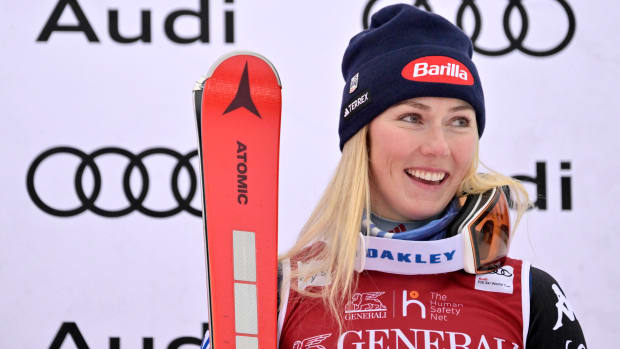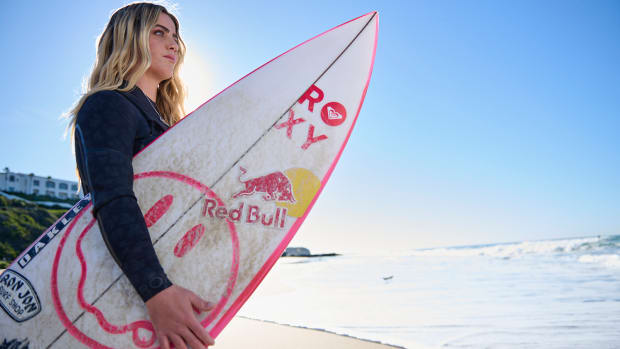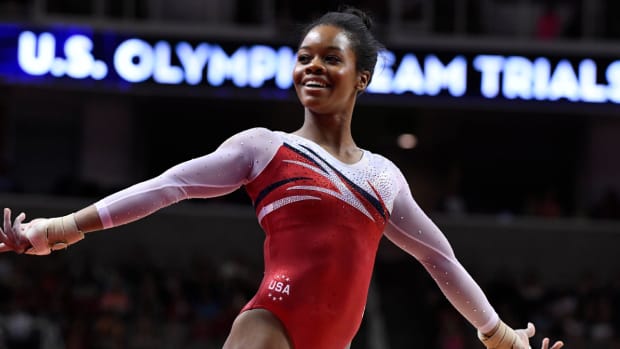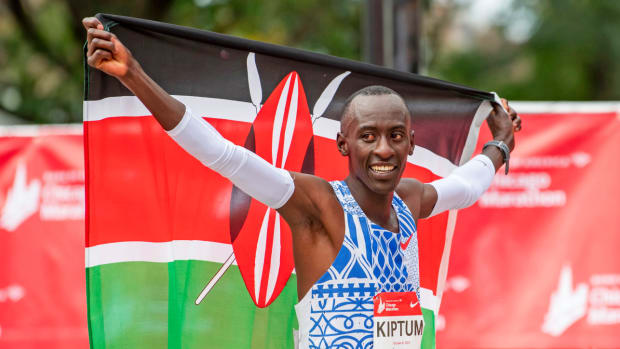Guts Over Fear: An Aggressive State of Mind Helped Mikaela Shiffrin Conquer Her Anxiety On The Slopes
On this January night, Mikaela Shiffrin is happy. She is riding in a car near the tiny Austrian village of Flachau and talking to me on her phone. There had been no skiing today, and would be none tomorrow, a blessed, brief vacation. (She had gotten her hair done that day, after weeks stuck inside a sweaty racing helmet. "Not the worst thing in the world, I know," Shiffrin says. "But I'm a girl.") Now she is en route to a rare, quiet dinner at the home of her ski technician. The previous night in Flachau she had won her fifth consecutive World Cup alpine race in a frantic nine days, despite trailing by nearly .4 seconds (that's a lot) after the first of two slalom runs. It was her 10th victory of the season in 17 races, extraordinary dominance. The Olympics lay barely a month off. But Shiffrin isn't happy because of any of this, although it's all very nice. She is happy because she is happy.
For nearly a decade, Shiffrin's performances have belied the digits on her birth certificate. Four years ago, when she was 18 and already renowned for her precocity, she earned the gold medal in slalom at the Sochi Games, becoming the youngest winner of the event in Olympic history. As of Jan. 28, she had 41 titles on the World Cup circuit; only one skier—Annemarie Moser-Pröll of Austria—had as many victories at age 22 (and Shiffrin still has two months and at least a dozen races to set the mark). Last year she won the World Cup overall title, awarded to the skier with the most total points across all five disciplines (slalom, giant slalom, downhill, Super G and combined) and indicative of the best skier on earth. In races often decided by the blink of an eye, she sometimes wins by a nice, cleansing yawn.
In March 2016, at the season-ending World Cup finals in St. Moritz, Switzerland, Shiffrin led the slalom by a full second after the first of two runs. Her coach at the time, Brandon Dyksterhouse, was the course-setter for the second run. (Coaches from various countries alternate setting courses.) Shiffrin's dominance was becoming so routine that Dyksterhouse, hewing to expectations of eye-popping margins, set the most difficult course possible. "The more challenging, the better she is, relative to the field," says Dyksterhouse. "So I set a course that was extremely offset, because I knew she would bridge that gap, where others would struggle." Shiffrin crushed the second run to win by 2.03, a stunning margin.
"IN RACES OFTEN DECIDED BY THE BLINK OF AN EYE, SHE SOMETIMES WINS BY A NICE, CLEANSING YAWN."
Shiffrin seemed to do all of this with ease, but a year ago, it became more difficult. Not the competition; Shiffrin had 11 victories and that overall title, in addition to her fourth slalom "globe." (FIS, the international ski federation, awards globe-shaped trophies to the season winners in each discipline, plus the overall; ski racers often cite their globe total as a measure of their success. Shiffrin's four slalom globes rank second all time.) The pressure to win became a challenge. Suddenly Shiffrin was deeply, painfully anxious. "I felt like I was going to throw up before every race," she says. A few times, she did.
The issue advanced on two fronts. First, Shiffrin's preparation in the fall and early winter of 2016 had been stunted by poor weather. She draws confidence from volume training and becomes uncertain without it. "I don't feel confident based on wins," says Shiffrin. "If I'm winning by getting lucky or pulling a rabbit out of a hat, that is not a confidence booster."
The second was pure performance anxiety, and her trepidation snowballed. "I started to worry about disappointing people," she says. "My team, the media. My feelings were scattered all over the place."
Shiffrin carried her insecurities into the offseason. She did a couple of sessions with a sports psychologist and threw herself into her preseason regimen, on and off the snow. On the weekend after Thanksgiving, she finished second in a giant slalom and first in a slalom at Killington in Vermont, where her anxiety had first surfaced a year earlier. Her nerves seemed to be settling. The next stop was Lake Louise, in Canada, where Shiffrin would challenge herself to ski outside the "technical" races of slalom (where she is dominant) and giant slalom (where she is always a threat) and compete in the "speed" disciplines of downhill and Super G. Still relatively new to those events, she was not considered a strong podium threat.
On Friday, Dec. 1, the day of the first of two downhills, Shiffrin waited at the top of the hill and listened to the 2014 Eminem song "Guts Over Fear," featuring Sia. Shiffrin had subsisted on a heavy diet of Coldplay for several years. "Guts Over Fear" had lived on a playlist but hadn't been her go-to inspiration until a few weeks earlier. Eminem took her somewhere new. "When I hear it, I go to this really dark place in my mind, where I'm really aggressive," says Shiffrin. "I feel almost insane. I can't imagine what everybody must be thinking when they look at me."
Guts over fear, the time is near
Guts over fear, I shall not tear
For all the times I let you push me around
And let you keep me down
Now I got guts over fear, guts over fear
The moment was transformative; the combination of lower expectations and new music set her free. "I wasn't nervous, I wasn't worried, I wasn't feeling any pressure to accomplish anything," says Shiffrin. "And nobody expected me to do anything. I was completely free." Shiffrin came in third, her best finish to date in a downhill; she won the downhill the next day and rocked the ski racing world. (As if Tom Brady had suddenly became a breakaway running threat.) "I found such a happy, aggressive, enjoyable place," she says. "I actually started to enjoy racing again and it's been ... so ... much ... fun."
On a Sunday afternoon in October, the Shiffrin household was buzzing in controlled chaos. Alpine ski racers are citizens of the world, but the Shiffrins keep a home in Avon, Colo., at the western edge of Vail. When I arrive, Mikaela's mother (and much more), Eileen, is standing at the mouth of the garage, which looks like a high-end ski shop, with dozens of skis hanging from a rack on the ceiling, and boots lined up nearby (this, despite the fact that most of Mikaela's gear is in Europe). Even though she arranged this interview, Eileen, surprised, covers her mouth with her hand. "I forgot," she says. It's understandable. In three days Eileen and Mikaela will leave for Europe, and return only once, briefly, in the next five months.
Inside the modest house, Mikaela's father, Jeff, an anesthesiologist, is wrestling with a broken ceiling vent. Her older brother, Taylor, 25, is heading out on a hike with his girlfriend. Eileen is worried that Mikaela, too, has forgotten about the interview. But she has not. "Of course I remember," Mikaela says to Eileen. "You told me." She plops onto the couch, ready to go.
In PyeongChang, Shiffrin will be a prohibitive favorite to win the gold medal in slalom and among the favorites in giant slalom and combined (a mix of downhill and slalom). She is a dangerous wild card in Super G and downhill, should she choose to race both. In broad strokes, she is a clear threat to win two gold medals and very much in the mix to win three ... or more. Only one woman in history has earned three golds at a single Olympics: Janica Kostelic of Croatia in 2002.And the sport has recently reminded Shiffrin that none of this is guaranteed. After winning 10 of her first 17 World Cup races, and five consecutive races from Jan. 1-9, Shiffrin’s next five starts, in late January, produced a third place, three DNF’s (in Super-G, giant slalom and slalom) and two seventh-place finishes. Still, she has been skiing in rarefied air.
"EVERYTHING LOOKS SO EASY, LIKE SHE IS DANCING A WALTZ."
To understand how Shiffrin reached the cusp of such historic success, it's important to understand the Team. Jeff, 63, and Eileen, 58, both grew up skiing in the Northeast and, after their marriage in 1986, built a social life around masters racing. Eventually their two children joined them on the slopes. Father and mother—especially mother—were the teachers. It's a fundamental part of the Shiffrin origin story that her parents insist they emphasized development over race-times, process over performance. Nevertheless, the results came. The kids learned skiing in the West and then both went to Burke (Vt.) Mountain Academy for high school. Taylor was good, Mikaela was a prodigy. She made her debut on the World Cup in 2011, just before her 16th birthday, and won her first World Cup race at 17.
Mikaela's first coach with the U.S. Ski Team was Roland Pfeifer, an Austrian who worked with her from 2011 to '15. Pfeifer was replaced in January 2015 by Dyksterhouse, who resigned in July '16. The current coach, Mike Day, specializes in the technical disciplines. Team Shiffrin also includes Jeff Lackie, who concentrates on the speed events and helps with strength and conditioning, and Atomic ski technician Kim Erlandsson. The Team overseer is Eileen, who is Mikaela's primary coach, travel bunkmate and motivator. There are countless moving parts in the Shiffrin snow show, from the top of the U.S. Ski Team to sponsors to race organizers to media. Mom has a hand in all of it.
"THE PARENT IS THE ONE PERSON IN YOUR LIFE WHO CAN SQUEEZE YOU WHEN THERE IS NOTHING LEFT TO SQUEEZE."
"Mikaela's success is a combination of who she is, and her relationship with her mother," says Dyksterhouse, who left the Team out of a desire to work with more athletes. "Mikaela lives, eats, sleeps and breathes ski racing. She wins a race, then she goes right to the gym. Mom is very driven and also very intense. You can have a coach-athlete relationship, but no one can push you like a parent. The parent is the one person in your life who can squeeze you when there is nothing left to squeeze."
There is a long history of parent-coaches at the highest levels of skiing. Marcel Hirscher of Austria, who has won the last six World Cup overall globes; Kostelic, who took 30 World Cup titles and three overall globes in a nine-year career cut short by injuries; and Marc Girardelli, an Austrian who competed for Luxembourg and won 46 World Cup races and two Olympic medals from 1980 to '96, were all coached by their fathers. Kostelic, now 36 and the State Secretary for Sports in Croatia, said in an email, "Having a member of your family [coaching] is a big advantage because it gives stability. I do not see anything difficult about it for the racer. I think it is more difficult to be the parent of a racer and a coach at the same time."
Dishing anonymously on the Shiffrins' mother-daughter dynamic is something of a hobby on the World Cup circuit. "That relationship is not built to last," says one racer, a comment representative of many others. This is a sensitive area that needs to be viewed in proper perspective. It's not, strictly speaking, normal for a 22-year-old woman to travel the circuit with her mother. But very little about the life of a U.S. ski racer is normal; she lives more than half the year on the road (not only the racing season, but also summer camps in New Zealand and Chile), often chasing optimal conditions while living out of multiple suitcases. Also, Mikaela Shiffrin is phenomenally successful. Jealousy is in play here.
Eileen speaks privately about formulating an eventual exit strategy but also remains driven. "She watches 10 times the video of any other coach," says Dyksterhouse. Jeff, who does not travel with the Team, says Eileen and Mikaela "could do any number of things. This could be the last year, or they could say, 'This is working so well, let's keep it going.' Personally, I stay out of it." If there is any tension between mother and daughter—and there is tension between every mother and daughter, whether in the pursuit of Olympic gold or not—it is not apparent and has not slowed the victory train.
Says Mikaela, "Four or five years ago, I was totally dependent on my mom. Now I trust myself more. But I keep asking my mom to be with me. She's an awesome travel companion and she makes sure I get the things I need, but first and foremost, she is my ski coach." (The Shiffrins fund all of Eileen's travel expenses. "I suppose we could be demanding and tell the [U.S.] ski team, You have to pay her," says Jeff. "But we don't.")
Also this: Last summer Mikaela began dating Mathieu Faivre, a 26-year-old French World Cup skier. "He's a ski racer, so he understands all that," says Mikaela. "If I have a bad day and I'm like, 'What if I've forgotten how to ski?' That's crazy, but he understands. He is the least complicated thing in my life."
"Mikaela is not a little girl, she is a young woman," says Eileen. "But this is not a walk in the park. In the end, this is an individual sport, and for Mikaela, it remains kind of lonely. But she's skiing really, really well, and when she's skiing well, everybody is happy."
"I FOUND SUCH A HAPPY, AGGRESSIVE, ENJOYABLE PLACE. IT'S BEEN SO ... MUCH ... FUN."
This is how Team Shiffrin operates: On Dec. 9, Shiffrin finished 20th in a Super G in St. Moritz. Ahead lay nine slalom and giant slalom races in 31 days across six countries. To prepare for this stretch Mikaela needed to train, but much of central Europe was buried in snow—great for powderhounds, lousy for ski racers who need hard, predictable surfaces. Lackie contacted a friend from Sweden, who recommended the team come to a training center in Trysil, Norway, three hours north of Oslo. The center had recently hosted a European Cup race (one level below the World Cup), leaving the hill hard and fast. Team Shiffrin flew to Norway on Monday, Dec. 11. "They put us all up in the same hotel, gave us a hill to ourselves, ran the chair lifts extra fast," says Lackie. "It was a perfect situation."
Shiffrin skied intensely for four days in Trysil. On the first full day, she did a total of more than 20 runs in three disciplines: slalom, giant slalom and the "city event," a parallel, head-to-head competition that was added to the World Cup recently. Then for three more days, she piled on the reps.
This, too, is essential Shiffrin. Her tolerance for volume training is legendary and creates the foundation for perfection in carving snow and ice. Ski racing punishes the body; every racer has an expiration date. Shiffrin has been remarkably healthy; her only serious injury on tour was a partial tear of her right medial collateral ligament and a hairline fracture of her tibial plateau in December 2015. She did not need surgery and returned to racing two months later. The pace of her winning is astounding: At Shiffrin's age Lindsey Vonn, the winningest woman in history, had only seven World Cup victories. Many on the circuit question how long Shiffrin can continue to out-train the world and stay healthy and engaged. (Vonn has won 19 races since turning 30, far more than any other woman in history; success is not linear or predictable in such a demanding sport.)
Says Dyksterhouse, "Mikaela is doing a huge volume of training, at least two times any other skier in the world, the majority of it on injected surfaces with ultra-aggressive equipment, unforgiving skis and boots. The wear and tear is phenomenal. You look at the women's ranks: Lindsey has been rebuilt multiple times. Lara Gut [of Switzerland] has been rebuilt. Anna Veith [of Austria] has been rebuilt. It's not a question of if you will get injured, it's a question of when. Mikaela has defied the odds, and you wonder when it will catch up to her."
Perhaps Shiffrin is an exception. In the four years since her gold in Sochi, she has become significantly more powerful. She is just over 5'7" and weighs 142 pounds, nearly the same as in 2014. "But I had baby fat then," Shiffrin says. "Now I have muscle." Four years ago she could squat 200 pounds once; now she can squat 270 pounds multiple times. Shiffrin's workouts are designed not only to help prevent injuries but also to prepare her for the longer, thigh-burning demands of the Super G and downhill. It is a challenge that all would-be five-event skiers face—transferring the technical precision required in slalom and GS to longer arcs and harrowing speed. "Mikaela's skiing tended to be quite mechanical, slightly rigid and robotic at times," says Day. "The goal has been to bring more flow to her skiing for the speed events."
It shows. Shiffrin's victory in Lake Louise came in just her fourth World Cup downhill. On Jan. 19, she was third in a downhill in Cortina, Italy, in just her fifth downhill. Kostelic, who won World Cup races in all five disciplines and world titles in the most disparate disciplines of slalom and downhill, says, "For me, it is impressive when someone is able to win in both slalom and downhill. It would be like someone winning [in track and field] the 100 meters and 3,000 meters. But Mikaela's movements are perfectly synchronized and everything is so harmonious. Everything looks so easy, like she is dancing a waltz."
But it can take a toll. In 2013, Shiffrin’s second season on the World Cup circuit, Tina Maze of Slovenia aggressively skied all five disciplines, won 11 races, reached the podium in 24 and scored a record 2,414 World Cup points. After the last race, says Shiffrin, Maze took Shiffrin’s face in her hands and, knowing that Shiffrin might someday attempt a similar feat, said "Don’t do it! It’s so exhausting!"
For now, Team Shiffrin continues to limit Mikaela's participation in speed events. She raced two downhills and a Super G at Lake Louise, one Super G at St. Moritz and she finished third in the downhill at Cortina last Friday. The schedule in PyeongChang works in her favor, with the two tech races coming first; any medal in the speed events would be gravy. Says Shiffrin, "Speed remains very much a work in progress for me." Dyksterhouse says, "I have no doubt that she will eventually translate her technical precision to downhill and become the most dominant speed skier on the planet."
Shiffrin has been through the Olympic wringer once. She says now that if she had known what it would be like, before Sochi, she would have been far more nervous. What Eileen said is true: Ski racing is an individual sport. But Team USA counts individual medals as its own and Shiffrin will arrive in PyeongChang as part of a U.S. team with fewer obvious contenders for the podium than in recent Games." There will be more pressure, and I will get nervous," said Shiffrin in mid-January, after her hot streak. "And there is a chance I will feel that pressure and let it get to me. But right now I'm feeling so good that I just don't see that happening." The struggles that followed her speaking these words are an illustration of the fine line between transcendence and failure.
For a long time Mikaela Shiffrin was defined by potential, by what she might someday accomplish with all her talent. Now she is often defined by those who ask if her success will be over soon. In the middle, she clings to the joy of the present. A transcendent skier, an Olympics far from home. Her time.







